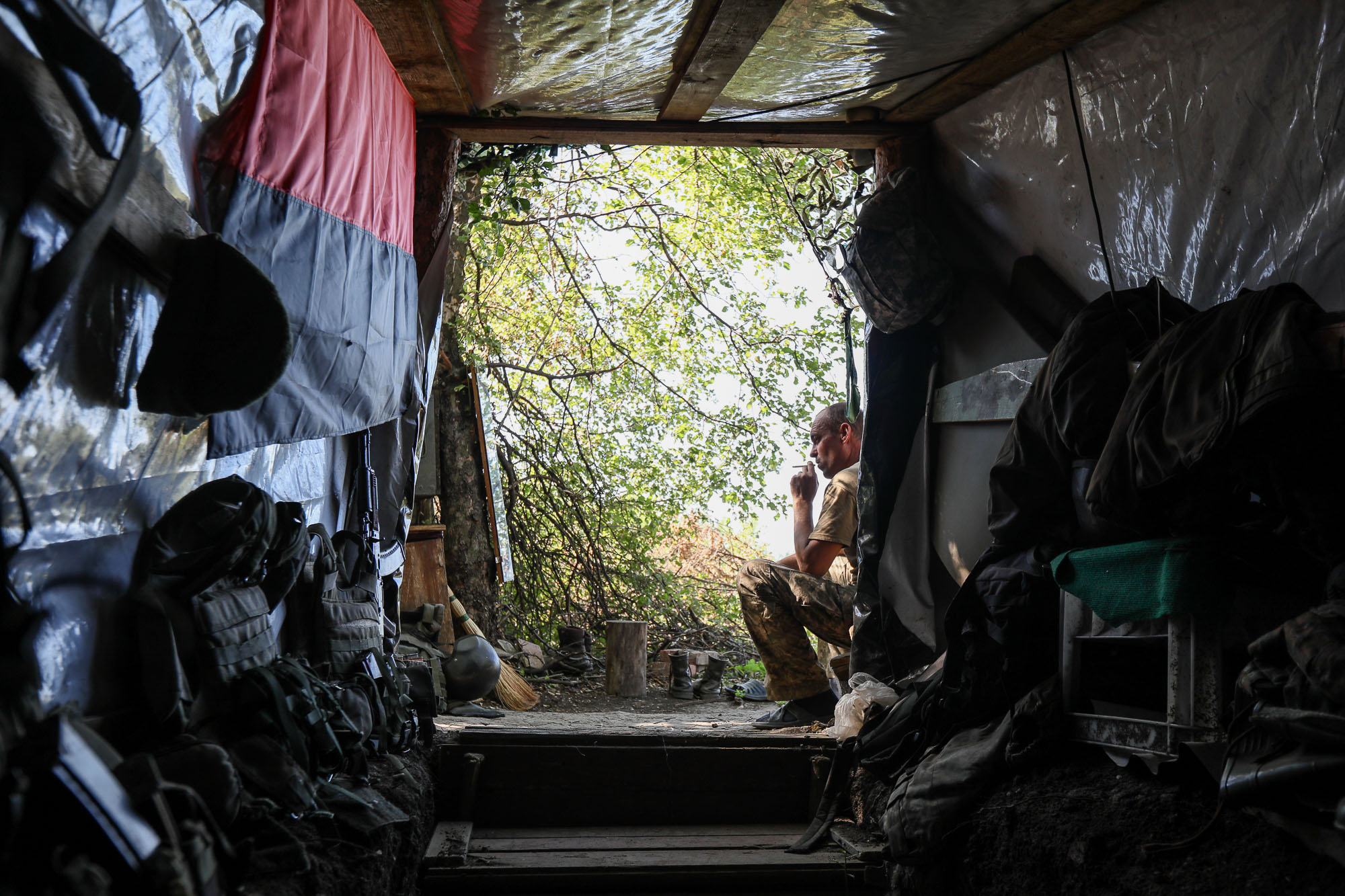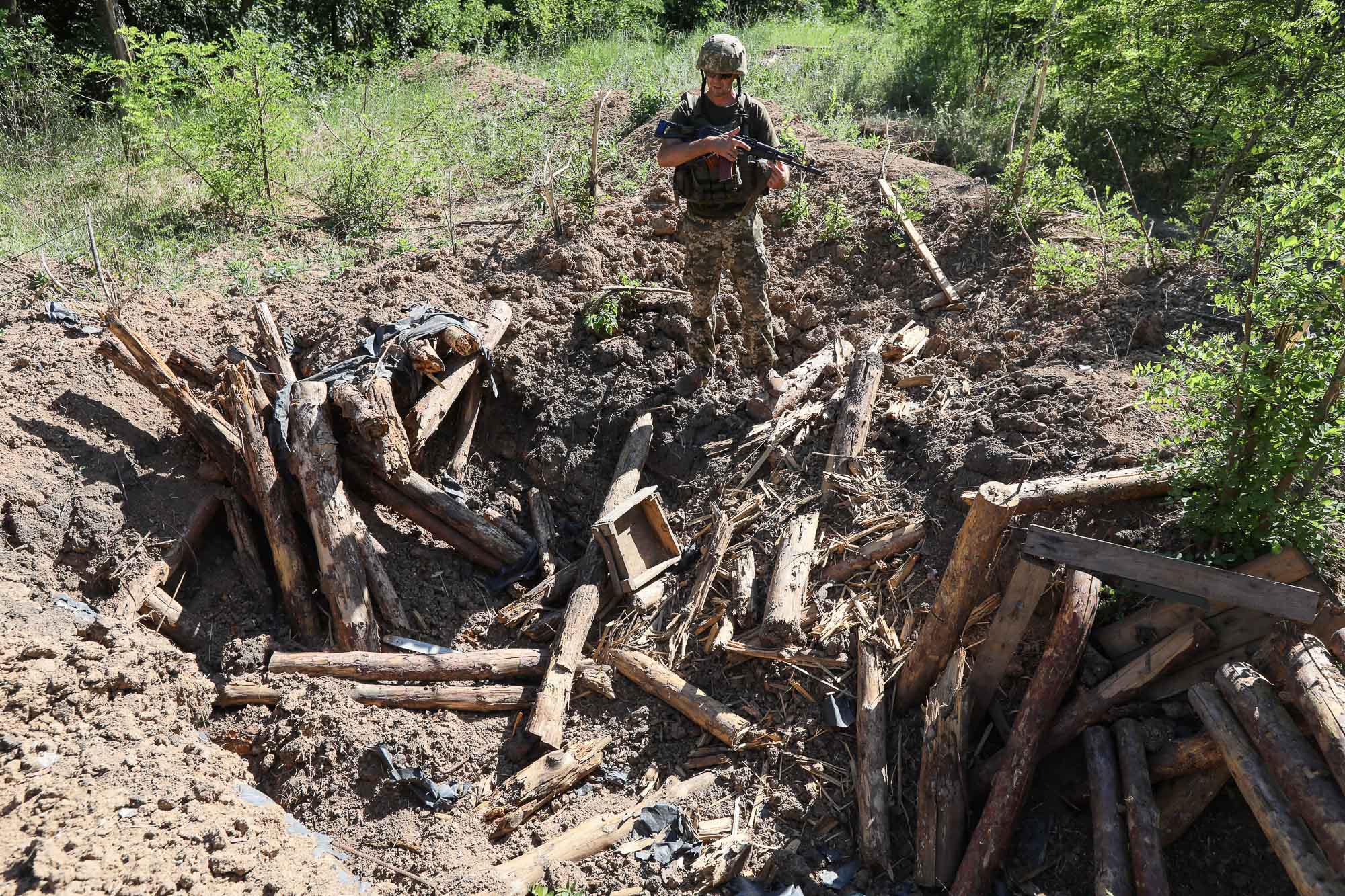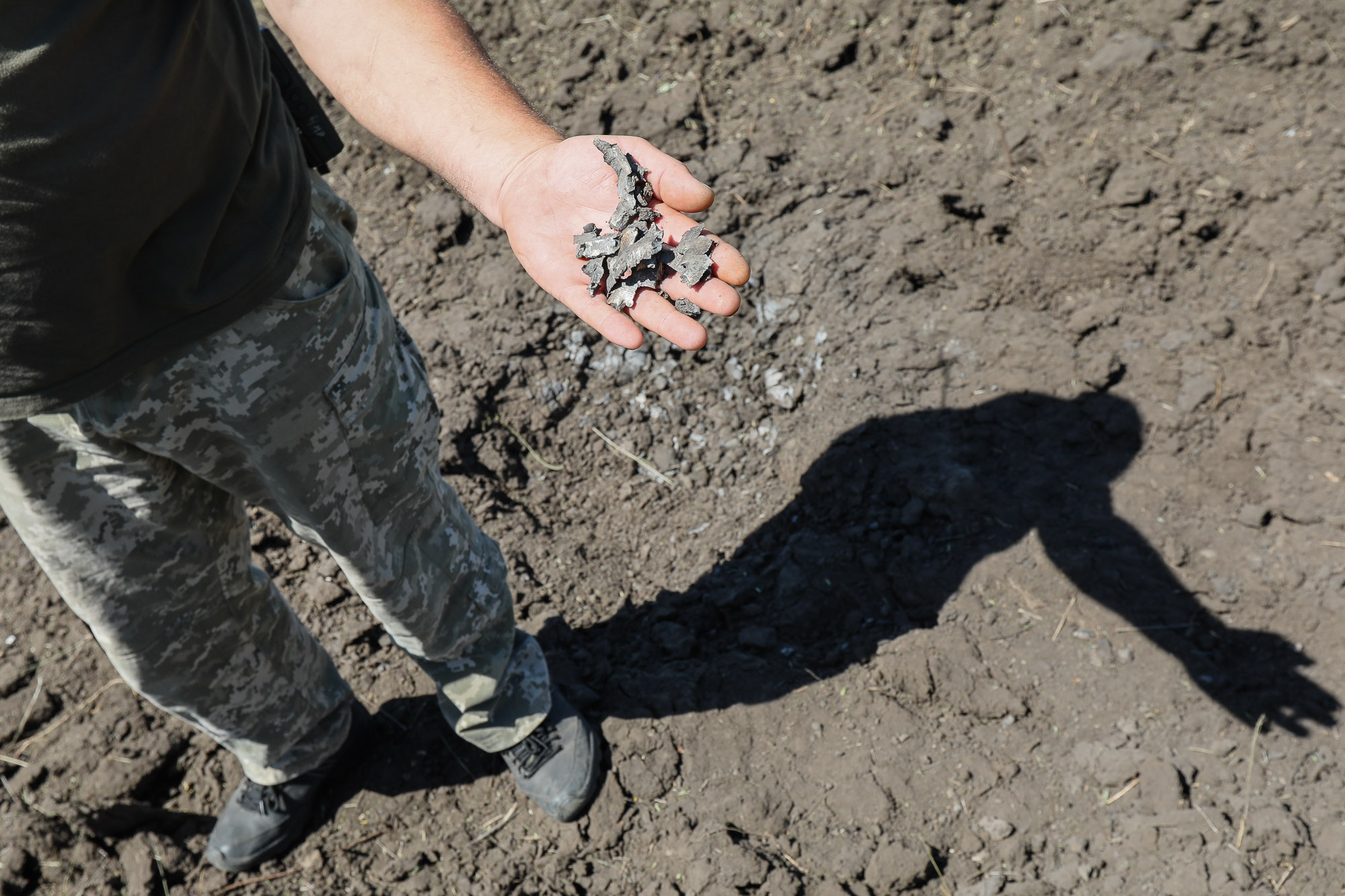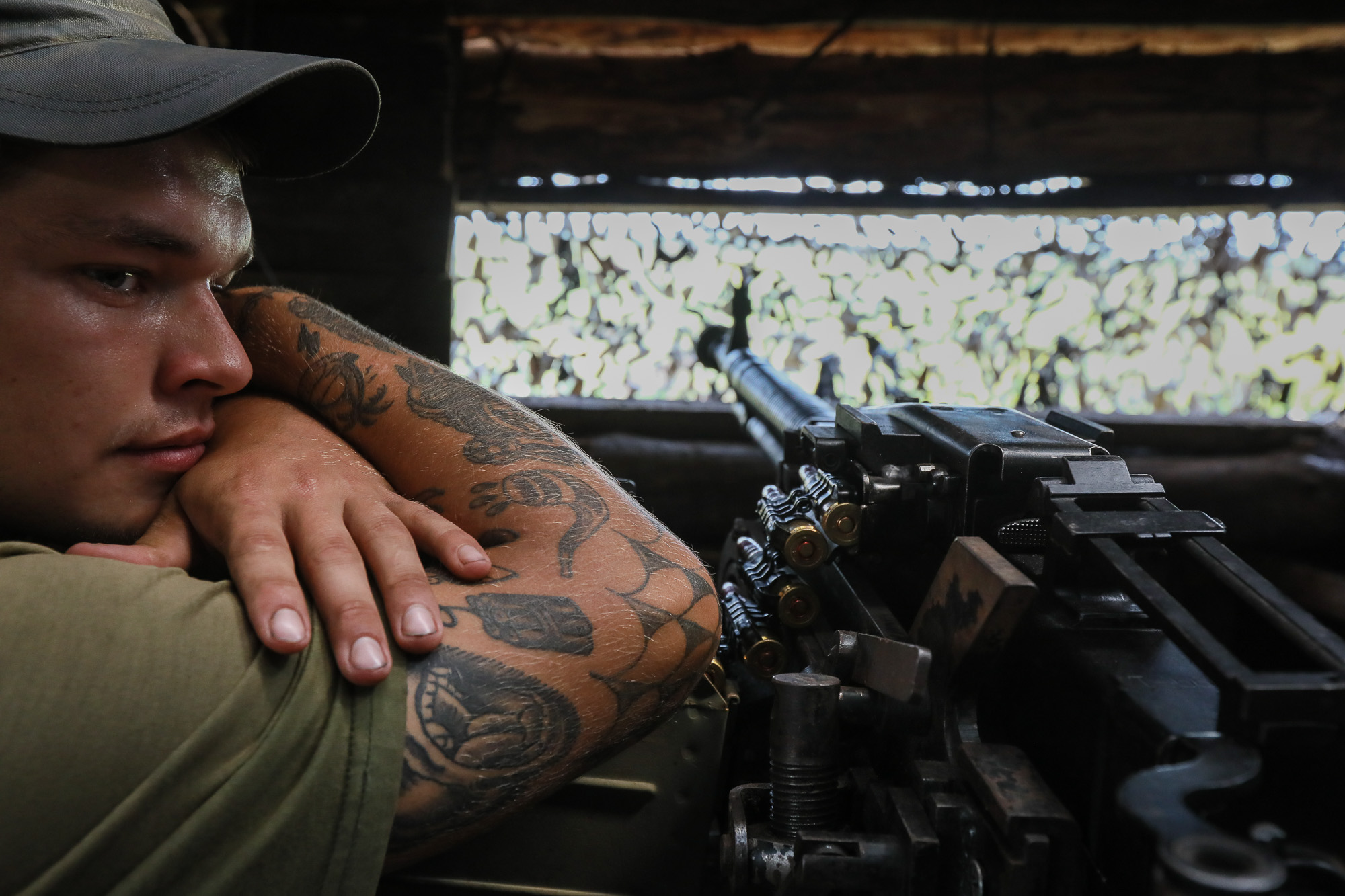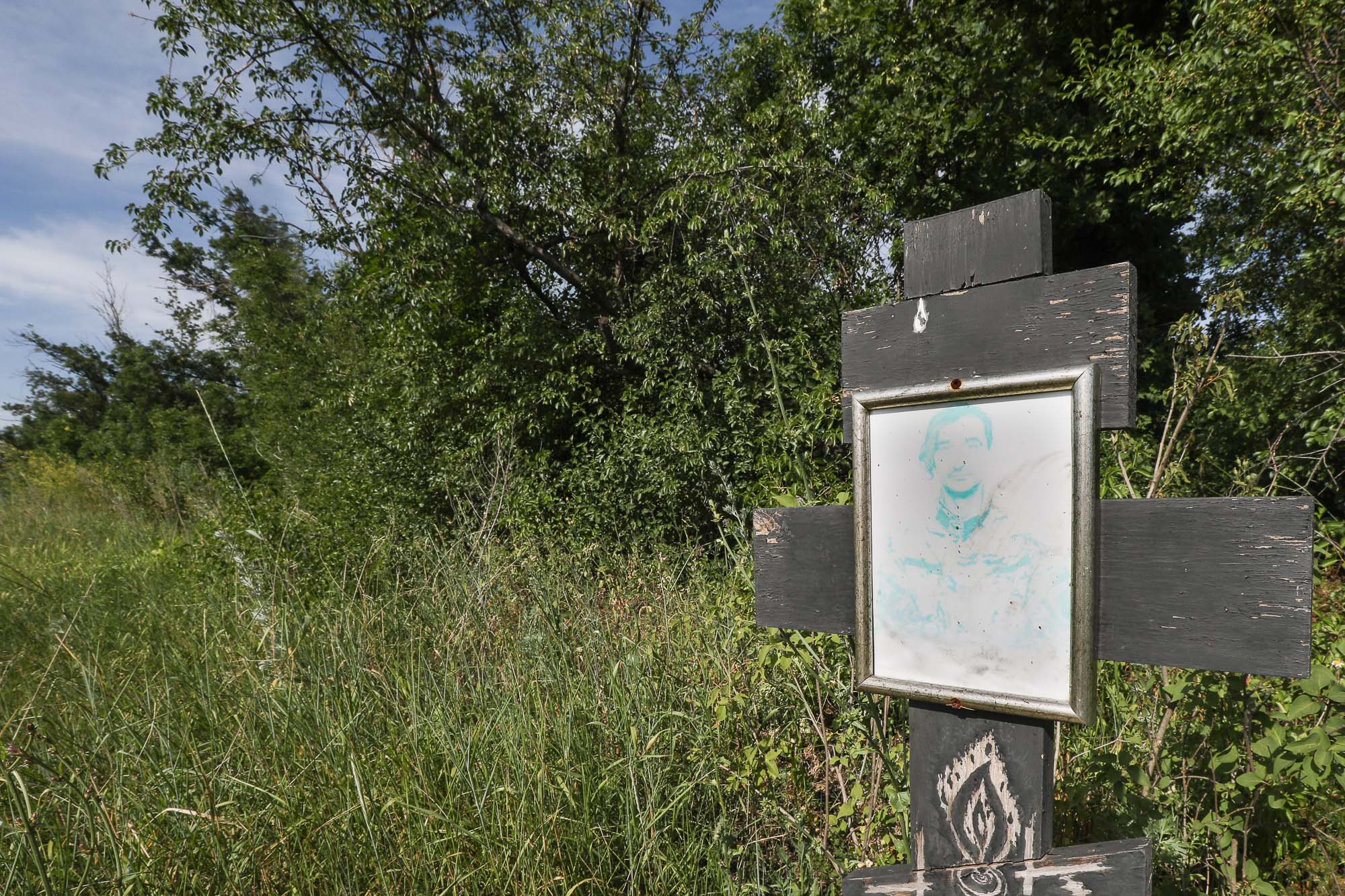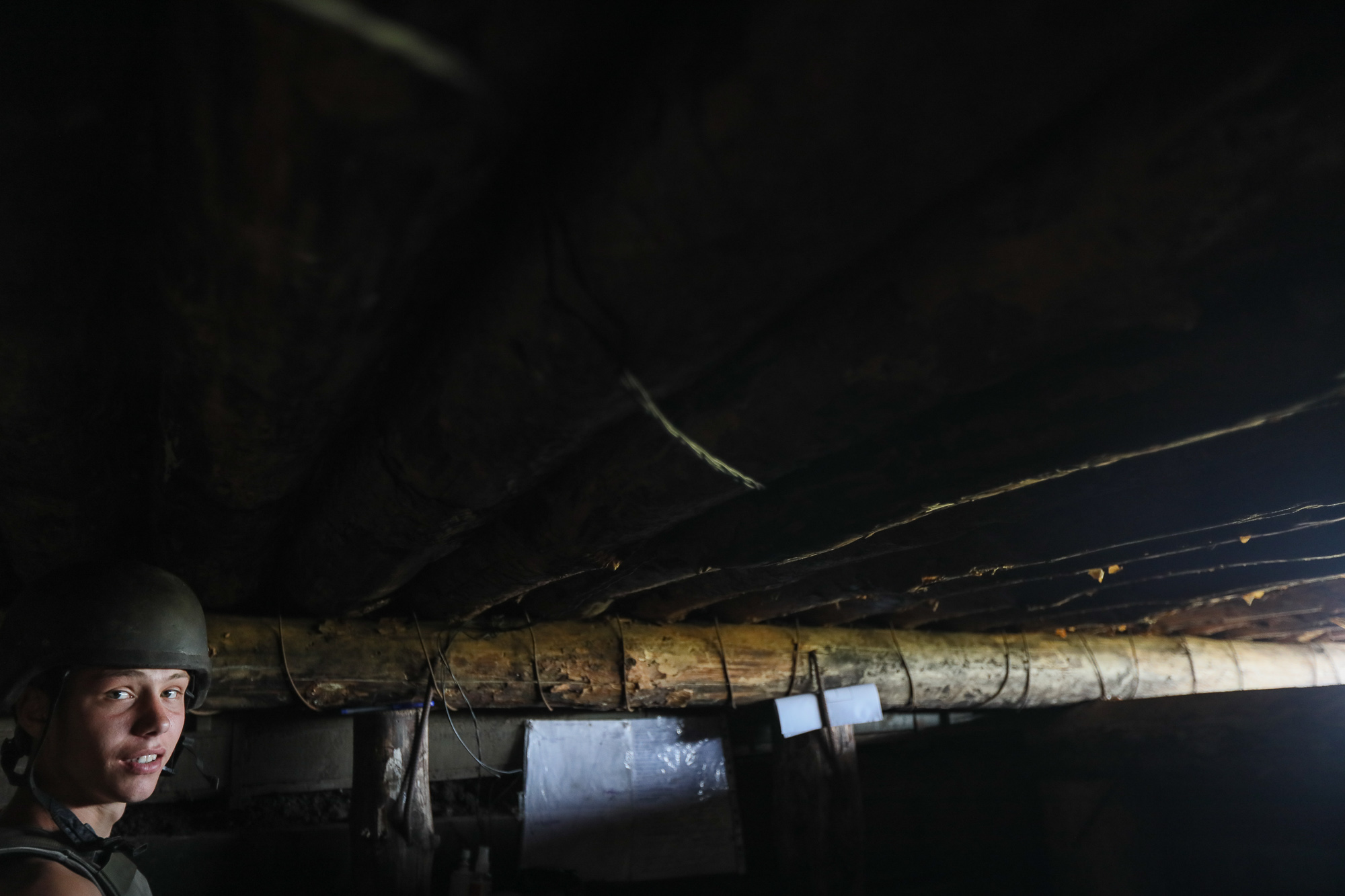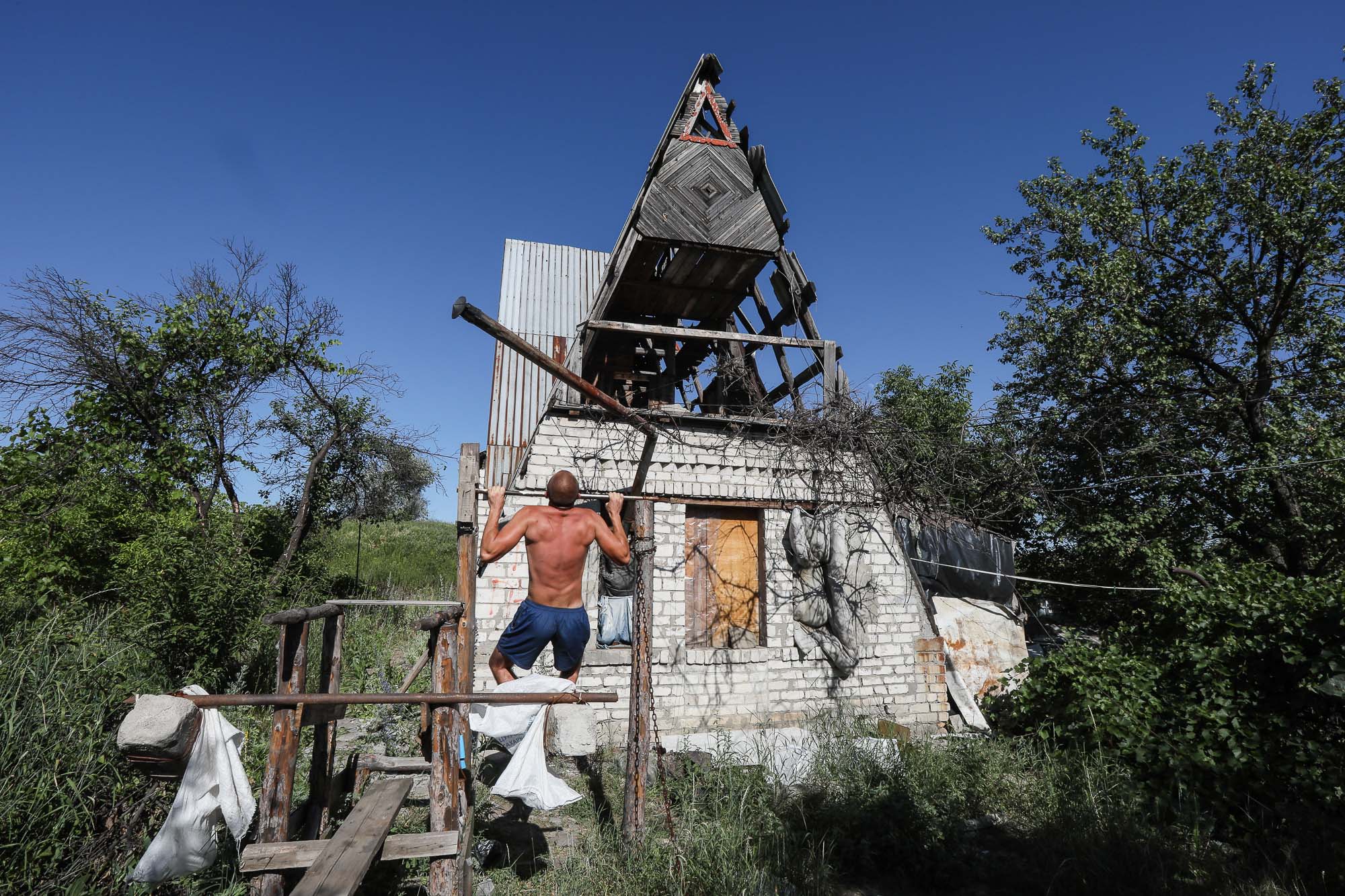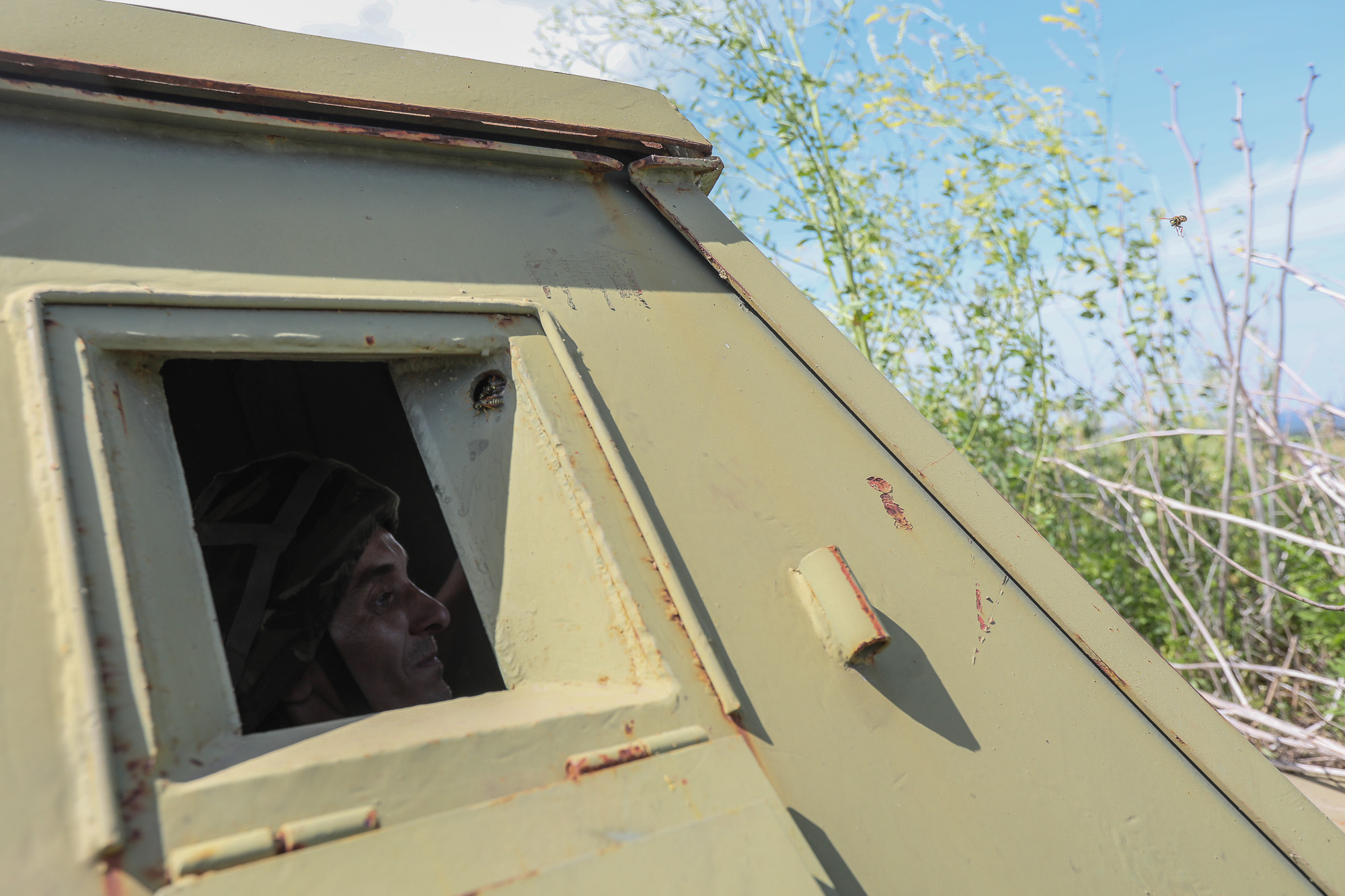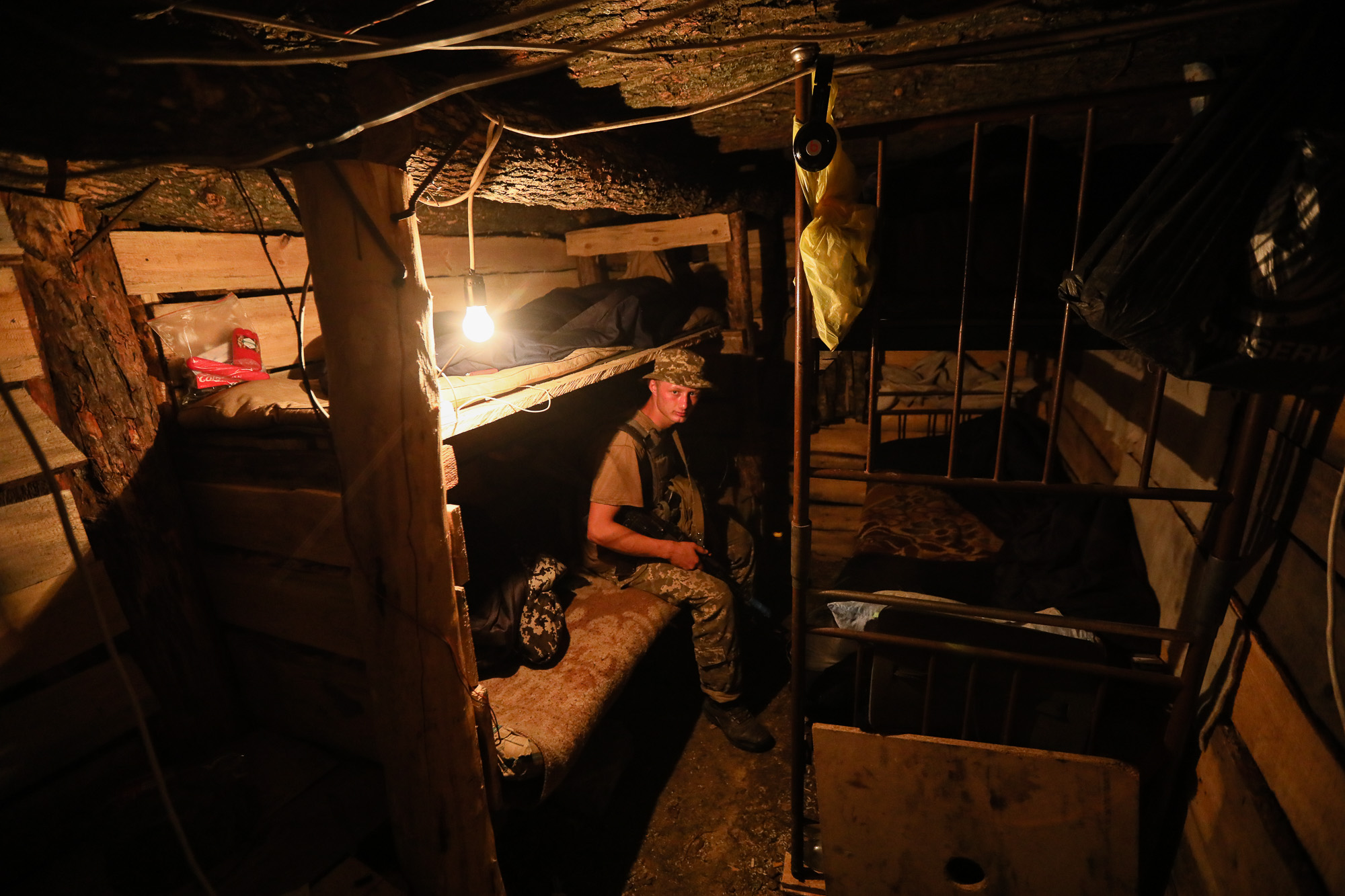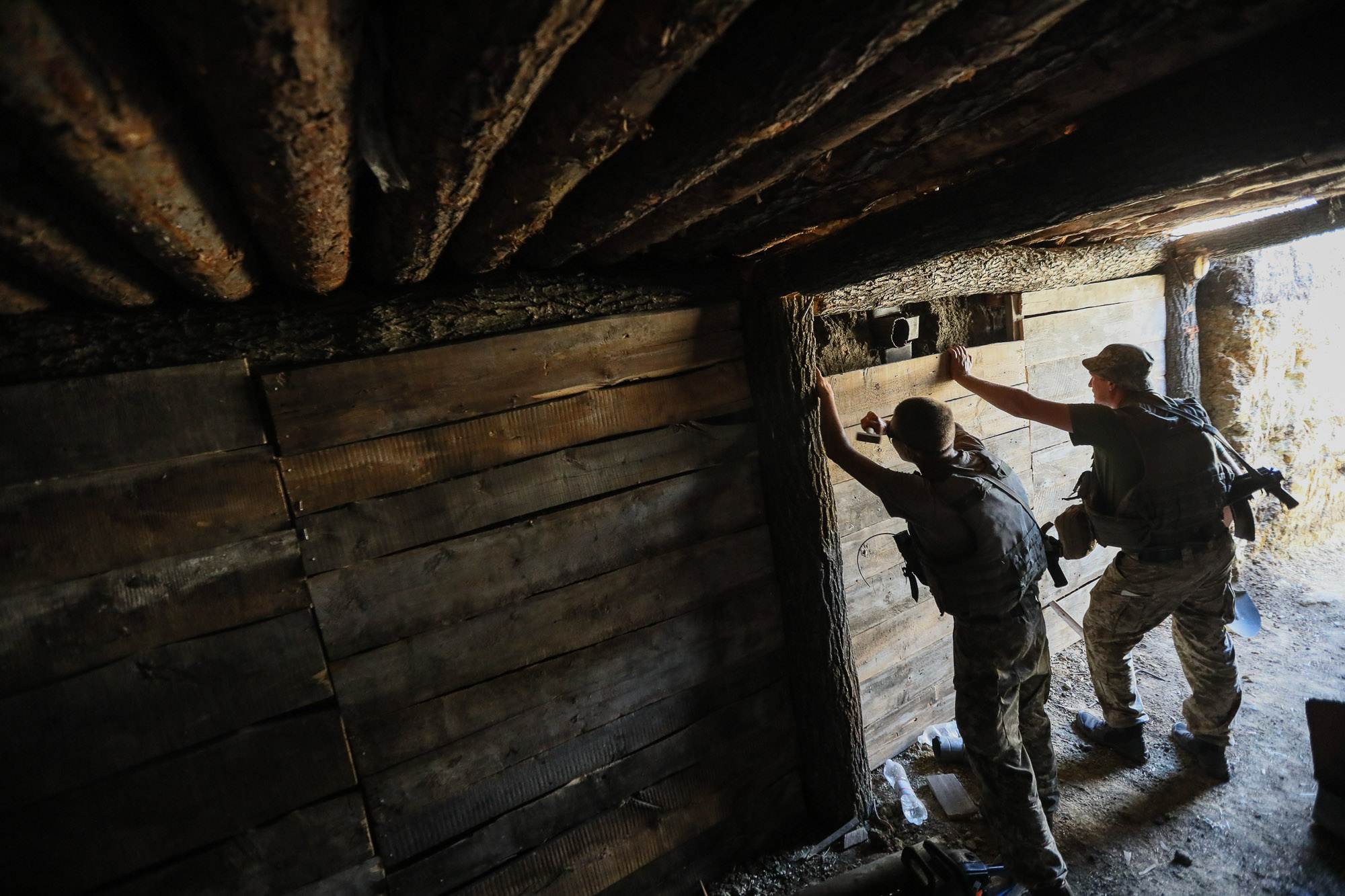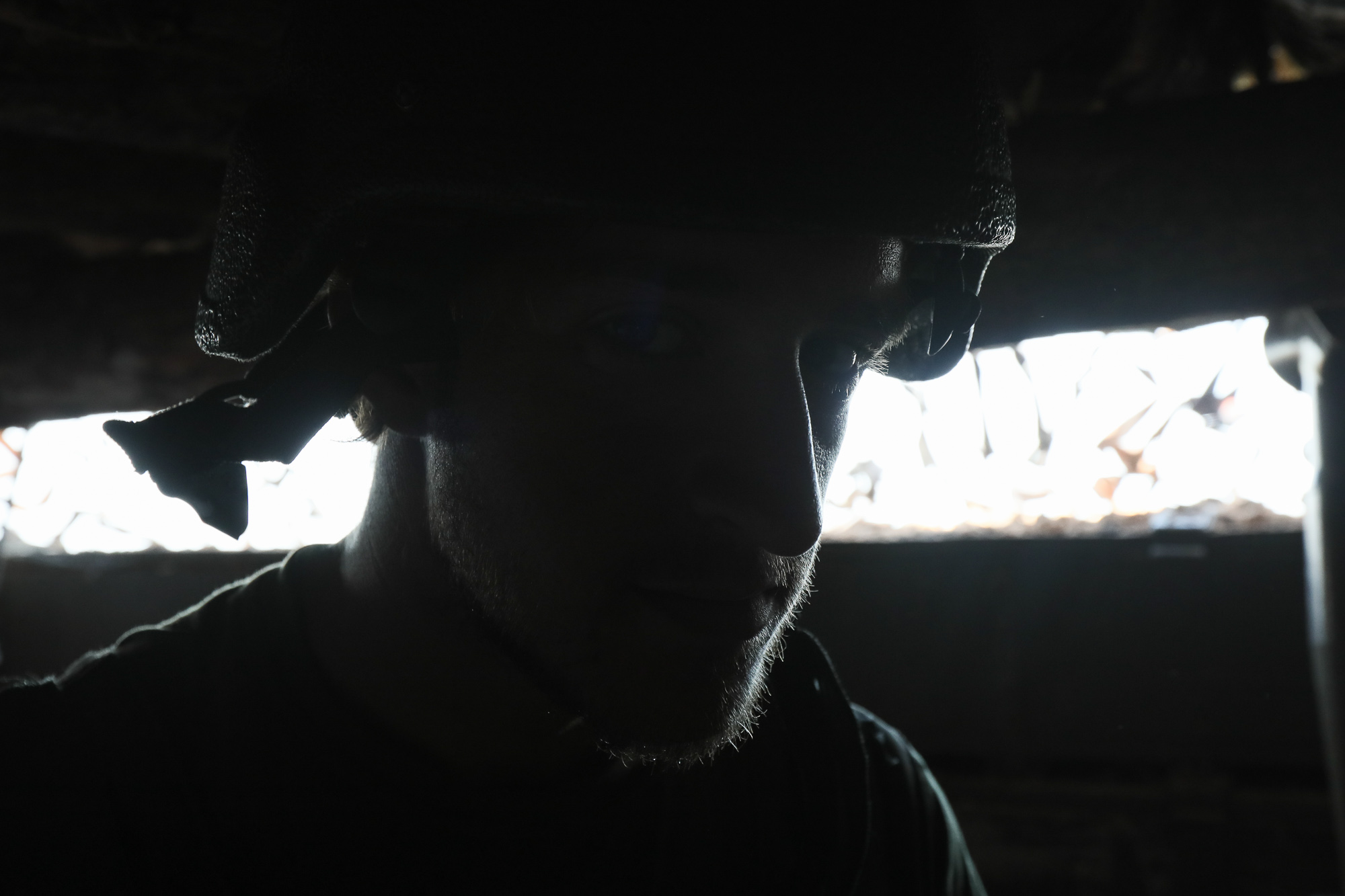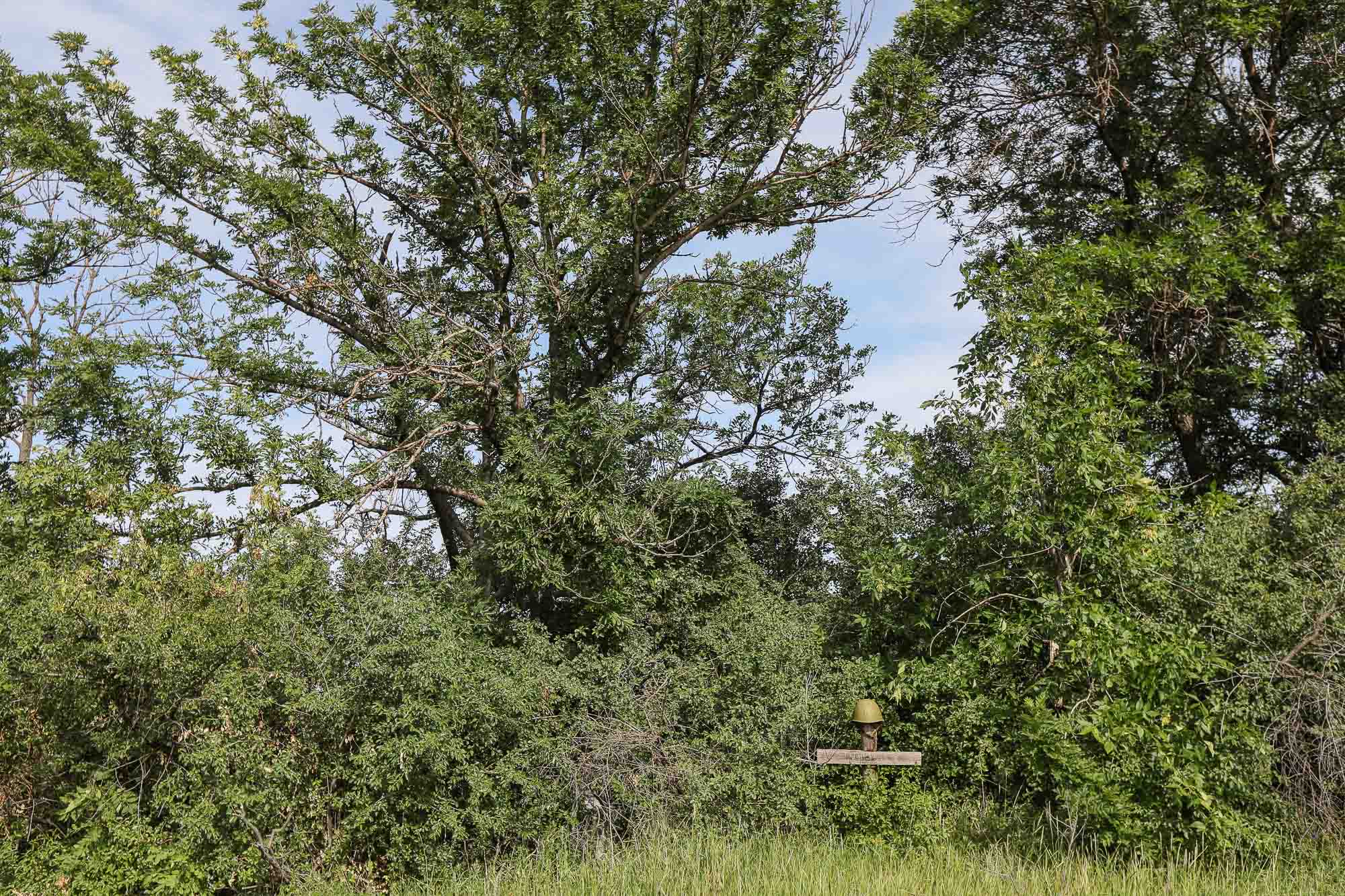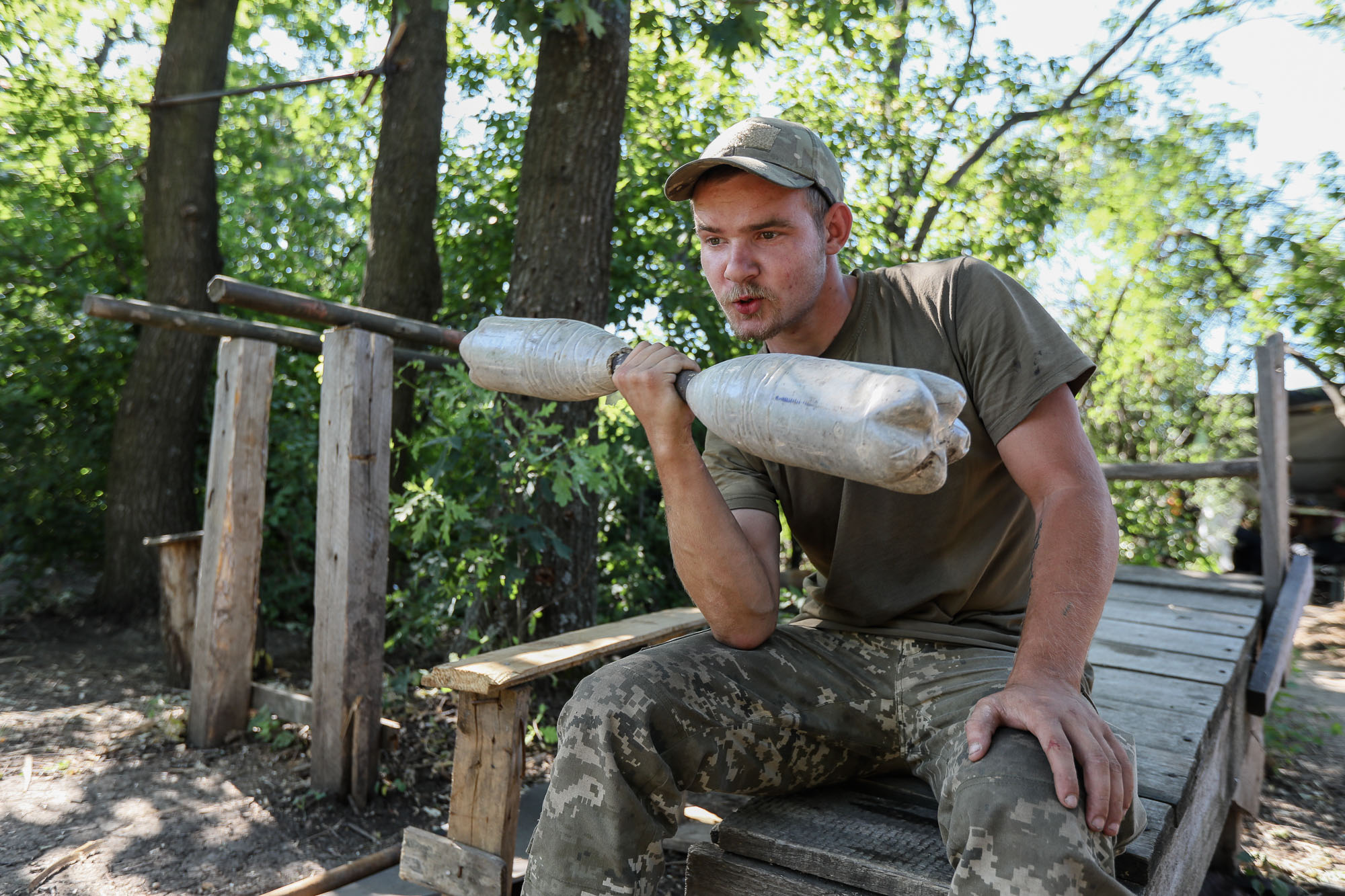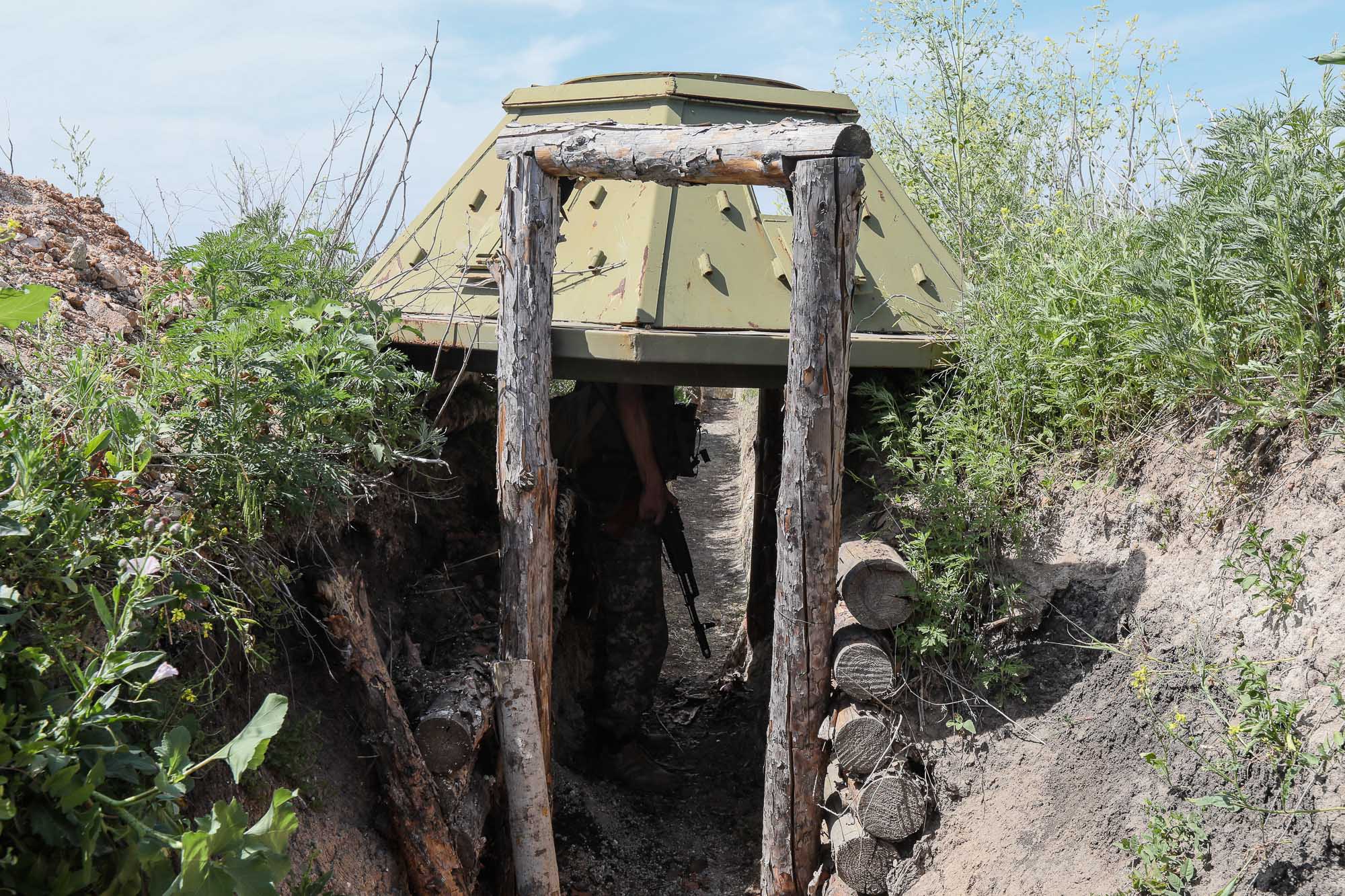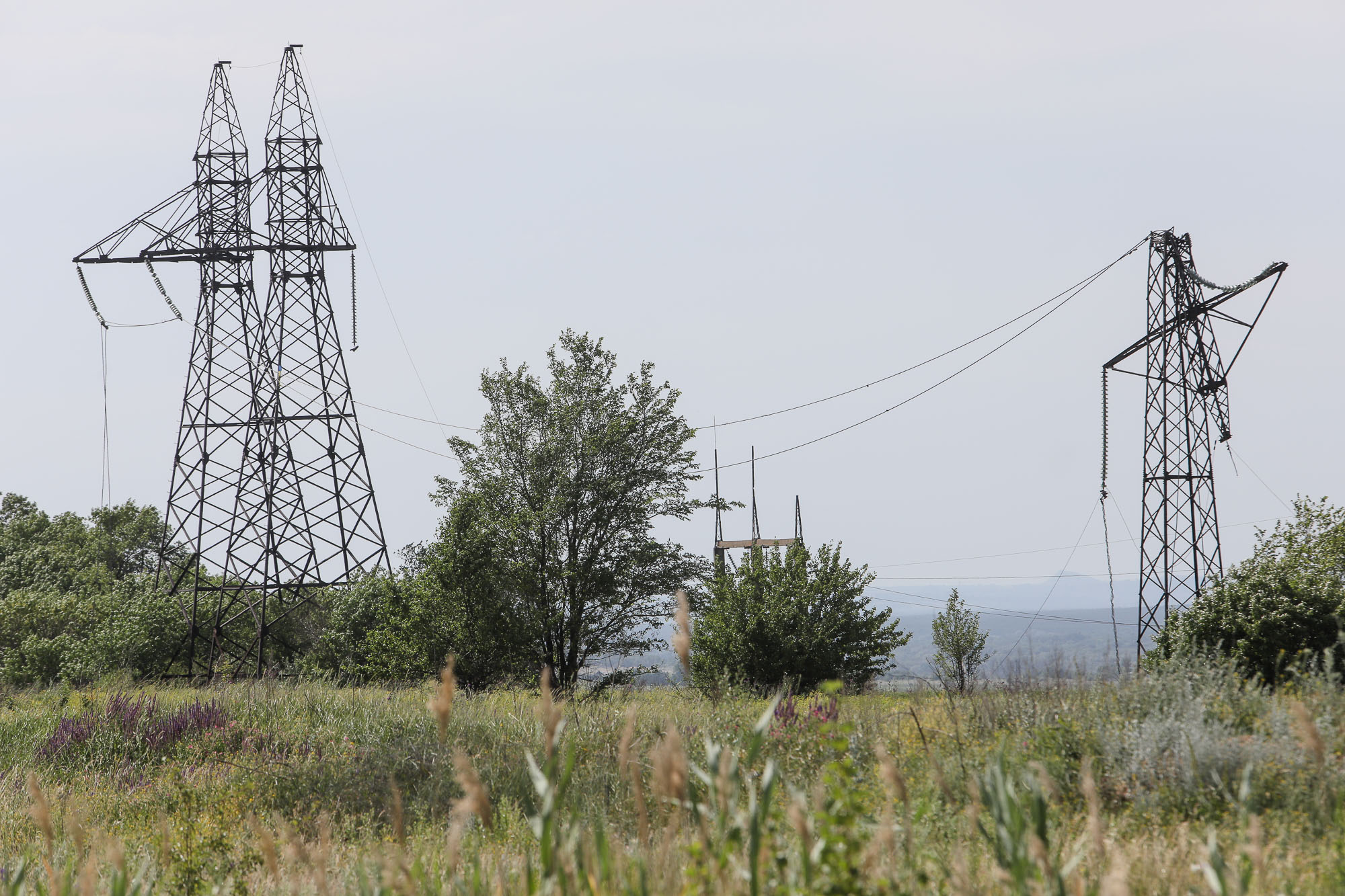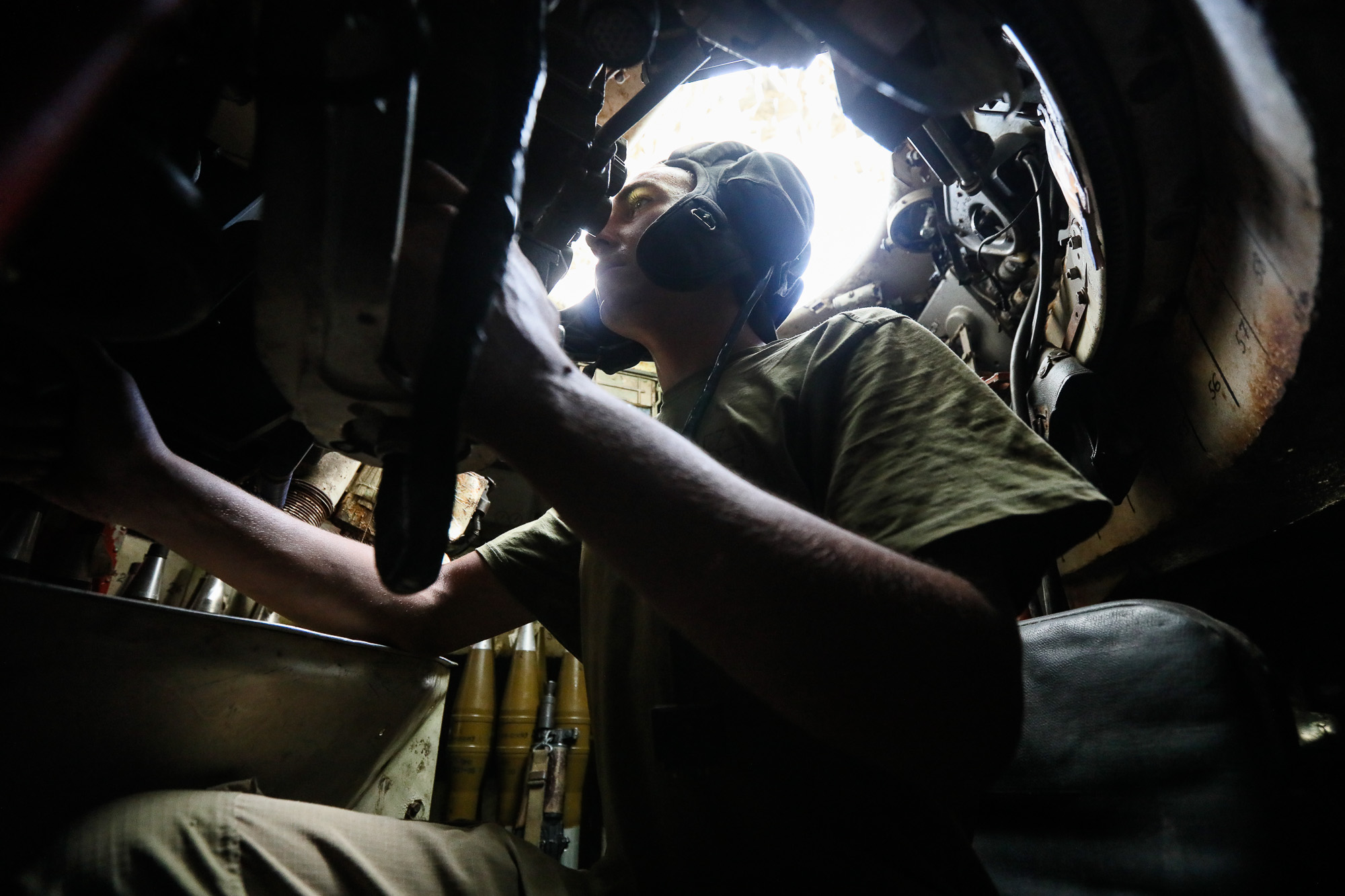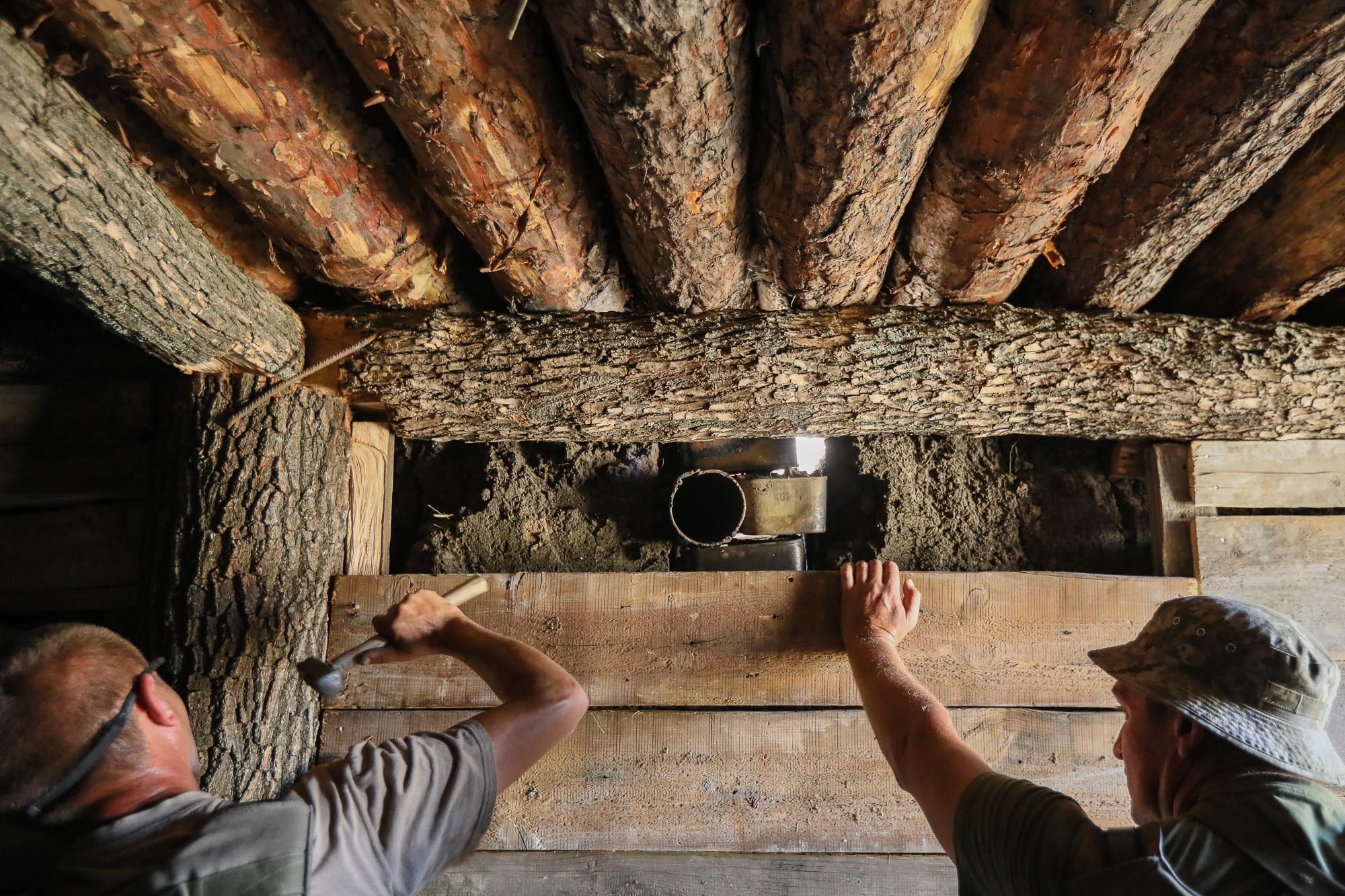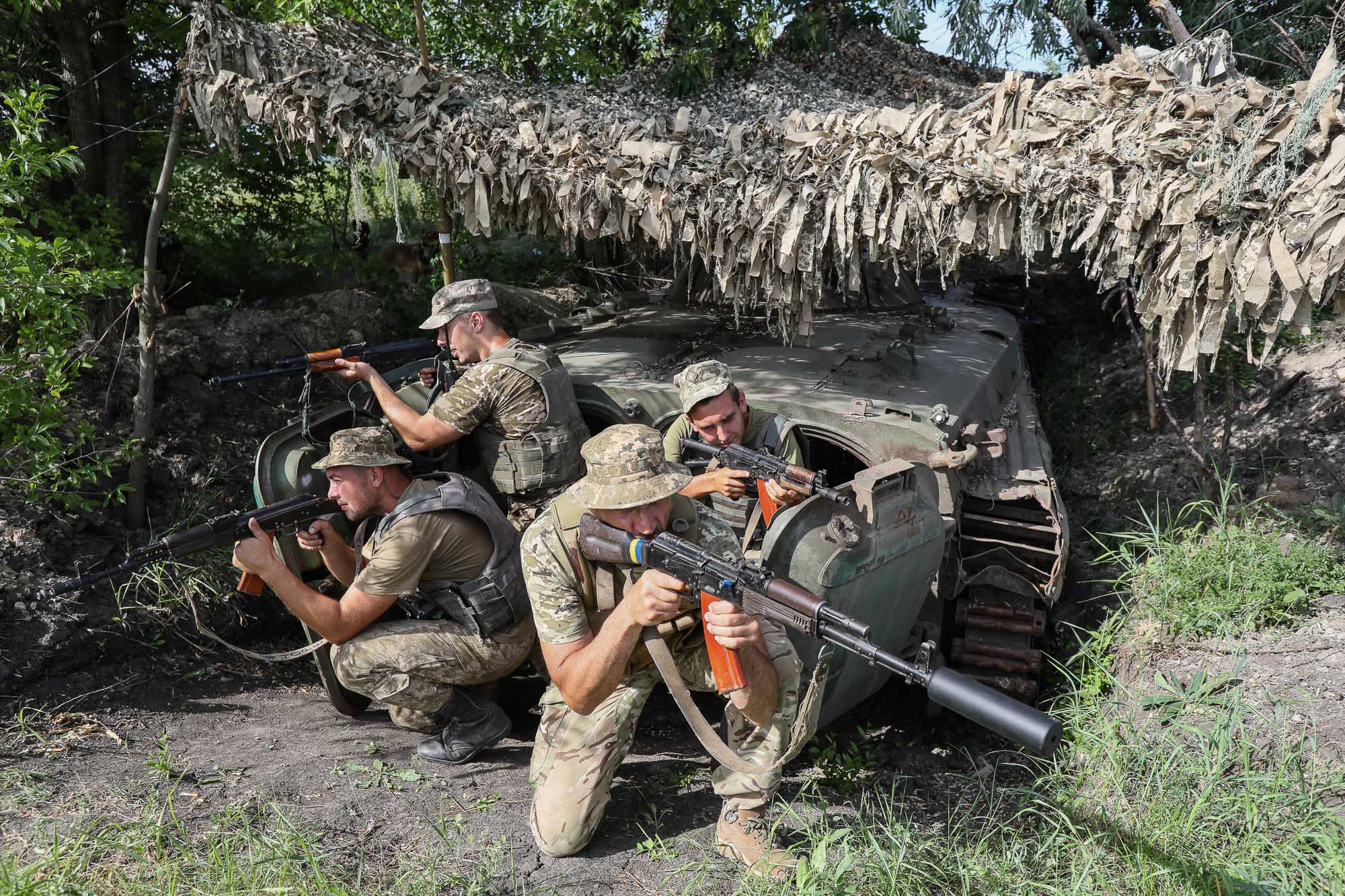NOVOTOSHKIVSKE and KRYMSKE, Ukraine — Dawn broke with shellfire on June 22 near the Luhansk Oblast frontline town of Novotoshkivske, some 600 kilometers southeast of Kyiv.
In a desolate field near a fortified Ukrainian army position defending the town, the ground started shaking and the air was rent by ear-splitting explosions and shockwaves. One after one, shell blasts burst from the field, throwing soil into the air and producing a dense haze of acrid smoke.
The heavy thunder continued to roll for several minutes, and then silence fell again on the blitzed battlefield.
By the light of day, as the Ukrainian soldiers emerged from their dugout shelters, they discovered at least 20 new impact craters from 122-millimeter artillery shells, a weapon banned under the Minsk agreements.
Fortunately, the attack resulted in no casualties.
For the Ukrainian military, this heavy strike by Russian-led forces, who hold ground just three kilometers to the south, came as no surprise. Despite dozens of cease-fires having been agreed at the negotiating table in Minsk (the latest one was supposed to start on July 1), the relentless stalemated warfare in the Donbas still drags on, with exchanges of fire by heavy weapons a regular occurrence.
While the combat areas are generally calm by day, the fighting flares up at night. The two warring parties, neither in a position to launch a successful major offensive, continue an exhausting, low-level struggle for strategic positions in the gray zone between their front lines.
Under the cloak of darkness, they fight for high ground or vital roadways, or probe each other’s defenses for weak points.
Despite that, the armies’ tactical maps have seen few changes in the past few years, and the war has become a never-ending, self-sustaining process, with no clear outcome in sight.
The June 22 shelling attack started at 4 a. m. local time, exactly on the day and the hour Nazi Germany invaded the Soviet Union 77 years ago in 1941.
“That was a kind of symbolic revenge upon us, the ‘fascists,’” the soldiers said as they picked up sharp shell fragments from black impact holes, still warm after the blasts.
“We expected them to do so. Those bastards deliberately selected fragmentation rounds to target as much manpower as possible.”
Many other positions of Ukraine’s 53rd Mechanized Brigade, which is currently defended the area, were also attacked at dawn. But as the new day broke, the sounds of war over Novotoshkivske died down.
But they erupted again after dusk.
Strategic road
On the battlefront between Novotoshkisvke and another key Ukrainian-controlled town — Krymske, some 12 kilometers to the east — a struggle is going on for control of a strategic road, the P‑66, one of Luhansk Oblast’s main arteries.
Dubbed the “Bakhmut Highway” by the military, it connects the key Ukrainian-controlled cities of Lysychansk and Sievierodonetsk, and then runs further east through the combat zone directly to Russian-occupied Luhansk.
That makes control of it a strategic goal for both sides.
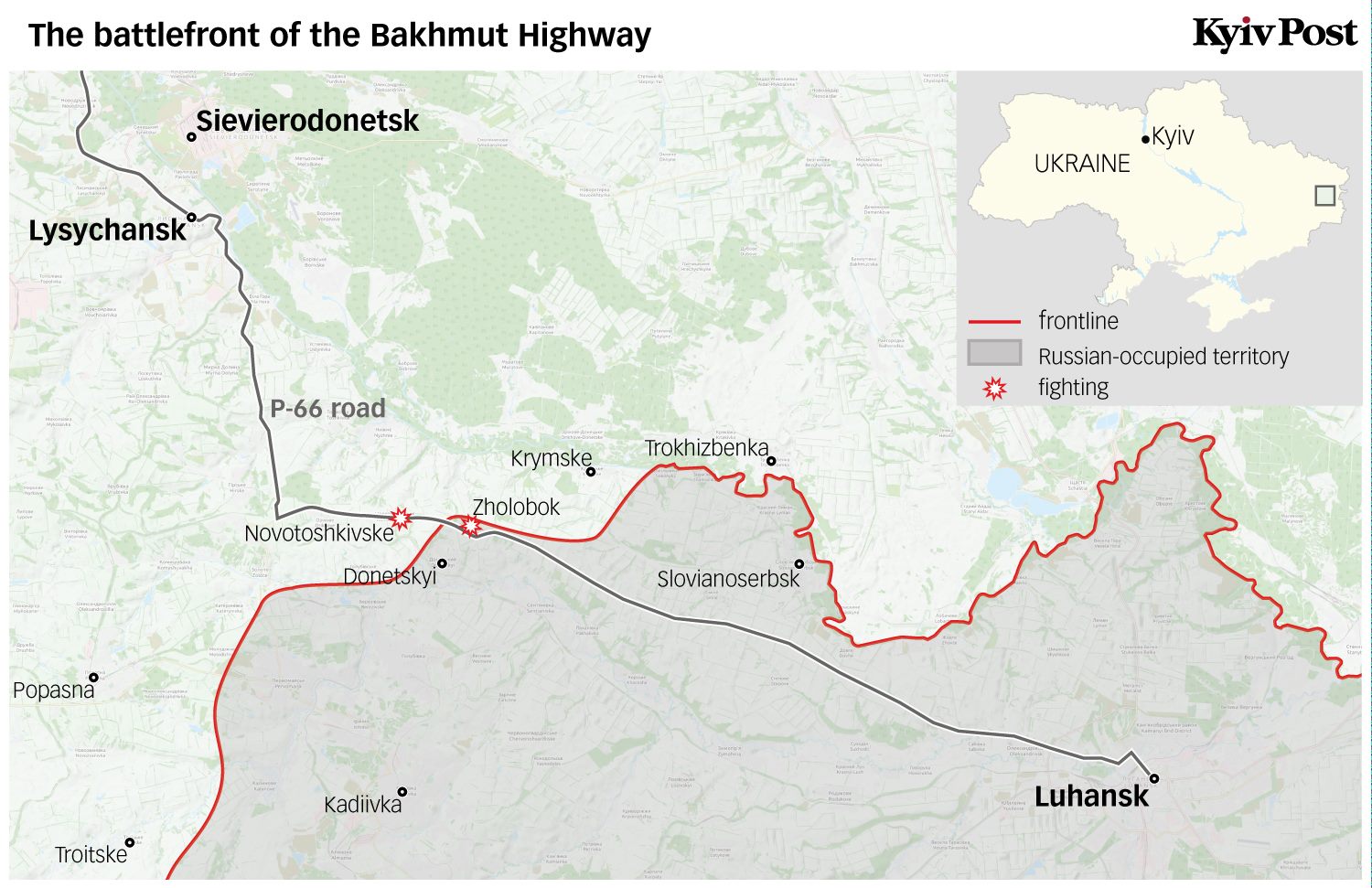
A map of the combat area in Russia’s war in the eastern Ukrainian Donbas along the strategic P-66 road, just west of the Russian-occupied city of Luhansk, which is located 827 kilometers southeast of Kyiv. (Yuliana Romanyshyn)
In late 2014 and early 2015, Russian-led forces managed to drive Ukrainian troops back from two fortified checkpoints, Nos. 32 and 31 on the Bakhmut Highway close to Luhansk, after dramatic battles with heavy death tolls.
Nevertheless, the Ukrainian defensive line reformed near Krymske and Novotoshkivske, allowing Ukraine to retain partial control over the crucial road.
In the summer of 2017, this area saw some of the heaviest outbreaks of fighting of the year. At that time, combat units from Ukraine’s 93th Mechanized Brigade knocked the enemy out of their positions south of the P‑66 road and gained new footholds on high ground just next to the Russian-occupied towns of Zhelobok and Donetskiy to the east of Novotoshkivke.
But after this advance, the situation in the area sank into deadlock again for another year.
Calm before storm
In the daytime, the war for the Bakhmut Highway is put on hold. Bursts of machine gun fire, thunderous blasts of incoming mortar shells, and battle cries are exchanged for ordinary chores.
Calm and easy going, the soldiers behind their field fortifications do laundry, and clean their weapons. At other times they smoke, drink tea or coffee and eat sandwiches, while others work out with makeshift weights and parallel bars.
Many among them are native to rural regions of Ukraine, so even when at war, they are comfortable with a country lifestyle. Right behind the combat line, one can sometimes find small enclosures with geese or pigs, raised by the soldiers mostly to fight boredom, rather than for food.
Farther behind the lines, in a block of destroyed summer cottages south of Novotoshkivske, the soldiers have even planted small patches of potatoes and tomatoes in deserted vegetable gardens right beside the front line’s trenches.
By day, many of the soldiers don’t even emerge from their trenches, preferring to hide from melting summer heat in their cool dugouts, chatting on Facebook or taking a nap after four-hour stints on duty.
“This is how it always feels after a hard fight,” says Sergeant Evhen Bondarenko as he sits on a wooden bench, sipping coffee from a metal jar. “With these skirmishes happening almost every night, and without any major changes for years, a soldier wants to set up his sweet home right here, at the front.”
But towards evening, the sounds of war return. A muffled clap comes from a wooded area near the front line — probably the report of a 40-millimeter under-barrel grenade launcher for an assault rifle.
“No worries, that’s not at us,” Bondarenko says.
In fact, this position is much safer than it was previously. After months of sustained fighting, Ukraine’s forces had by mid-June managed to advance several hundred meters towards the enemy lines south of Novotoshkivkse, thus securing their rearwards defenses and the town from enemy fire.
This tactic of a creeping advance, carried out by the army’s best-trained scouting teams, is bearing fruit. Ukrainian troops now hold positions in a semi-circle around the Russian-occupied towns of Donetskiy and Zhelobok, which are located right beside the P‑66 highway. Retaking the towns is now a real possibility, although the enemy would not yield control of this part of the strategic road without a bloody battle.
Coming home
And the defenders of another key Ukrainian-controlled town of Krymske, 12 kilometers east of Novotoshkivke, certainly don’t expect the war to peter out without further fighting.
A company of soldiers commanded by Senior Lieutenant Dmytro Lysytsya, a young officer originally from Luhansk, is digging in hard to turn their area into a fortress should major fighting for the Bakhmut Highway start again.
“In fact, here we’re facing the hostile territory from three directions,” the officer says as he points to swathes of flat, central Donbas steppe to the south and east.
“Besides, the militants often hit us from inside civilian areas, for instance (from the occupied villages of Sokolnyky and Znamenka approximately 5 kilometers to the east).”
“So my guys here are doing a good job of what every infantry trooper should be perfect at — building new fortifications to meet an attacking enemy with full firepower.”
Lysytsya has ordered most of his fighters to rest in their cool underground shelters during the peak of the summer heat between noon and 4 p. m. Under the blazing sun and in full combat gear, he walks along the line newly built dugouts and trenches, checking every soldier on duty is at his post and on the alert.
Behind the rear line of his company’s strongpoint, several lonely memorial crosses stand, a sad remembrance of the past heavy fighting for this small patch of flat steppe on the southern bank of the Siverskiy Donets River.
“That’s where the guys from the 93rd Brigade were killed in action last summer,” the young officer says as he salutes the memorials. “Sometimes, I sit near them all night long to unburden my soul.”
As evening descends again on the war front, Lysytsya picks up his radio set and orders his troops to gradually increase their combat readiness: “Wake up, boys. The rumble is about to start soon.”
“I’m sure we will end this sitting war,” he adds as he looks towards his Russian-occupied home city of Luhansk to the east of his trenches. “We will get back home some sunny day.”
“Some of Ukraine’s sons will have the honor of being killed in combat for their country, just like those guys from the 93rd. I believe we’re all ready for this.”
